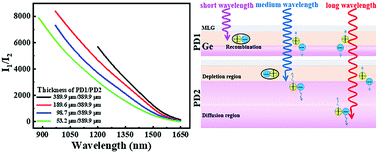Highly sensitive filterless near-infrared wavelength sensors with two self-driven MLG/Ge heterojunctions†
Abstract
This paper reports a near-infrared wavelength sensor composed of two stacked monolayer graphene (MLG)/Ge heterojunction devices, which could enable the determination of the wavelength quantitatively. Since the absorption coefficient of Ge is wavelength dependent, the technical computer-aided design simulation shows a significant difference in the photon generation rate distribution of the two MLG/Ge photodetectors. Such a variation in photon absorption leads to a completely different evolution of the photocurrent in the stacked devices. Further experimental analysis found that the correlation between the photocurrent ratio (I1/I2) of the two MLG/Ge heterojunctions and the wavelength can be easily expressed using a monotonic function, by which the wavelengths in the near-infrared light range (880 nm to 1650 nm) could be calculated. It is worth noting that the detection band could be appropriately adjusted by changing the thickness of the Ge sheet employed in the photodetector. Moreover, the average relative error and average absolute error of the wavelength sensor are estimated to be 0.5% and 6.1 nm, respectively, which is comparable to the most investigated visible band wavelength sensor.



 Please wait while we load your content...
Please wait while we load your content...